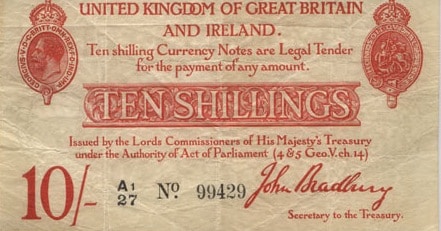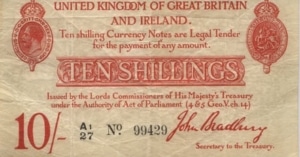The 10-shilling note was introduced in 1928 due to the mounting pressure on gold reserves due to World War 1; but how much is a 10-shilling note worth today?
In 2022, 10-shilling notes sell for around £3.50 on average according to values on eBay but this can vary greatly depending on the condition of the note and what year it was issued. Some 10-shilling notes sell for hundreds of pounds at auction, so it really depends on the type of note that you have.
Read more to find out much more about the 10-shilling note, including its design and history.
What Is A 10-Shilling Note?
The 10-shilling note was a banknote similar to the £5 or £10 notes used in the United Kingdom that was issued between 1928 and 1969. Prior to decimalisation, the 10-shilling note was worth half of a pound and was written as ’10s’.
The 10-shilling note was the smallest denomination of note ever used in the United Kingdom and was eventually replaced by the 50 pence coin.
History Of The Note
In the 18th and 19th centuries, banknotes were handwritten or partially printed and exchangeable for gold. This was a feasible exchange until World War One when gold reserves became crucially important to maintain.
At this point, the Treasury introduced one pound and 10-shilling notes, although it wasn’t until 1928 that the Bank of England took the responsibility of printing the 10-shilling notes.
In the introduction, the 10-shilling notes became known as ‘Bradburys’ because of the figure of Sir John Bradbury, Permanent Secretary to the Treasury at the time, displayed on the notes.
In 1925 Britain returned to the gold standard but the threshold for exchanging currency for gold was increased to a minimum of 400 ounces or more. It wasn’t until 1931 that the gold standard ceased to be used in Britain.
Design Of The 10-Shilling Note
The design of the 10-shilling note remained the same from the introduction of the note in the Bank of England from 1928 until 1961. The design featured below was signed by Sir John Bradbury and was initially released with a red-brown colour scheme and dimensions of 136mm x 78mm. This initial design is known as the Series A first issue.
The colour scheme was altered in an emergency wartime issue in 1940 during World War Two to mauve and grey, but the design and dimensions remained the same. At this time a metallic feature was added to the notes to reduce counterfeiting activity.
This metallic safety feature was not included in 10-shilling notes produced immediately after World War Two but shortly returned in those issued from October 1948 onwards.
The Series A second and third issues were both brought into circulation in 1948 following the war and brought the return to the original red and brown colour scheme.
All of the series A notes including the first issue ceased to be legal tender in October 1962, when a Series C version was introduced featuring a design of Queen Elizabeth II on the front. The new Series C 10-shilling notes had new dimensions of 140mm by 67mm and were the first 10-shilling notes to feature portraits.
A Series D design featuring a portrait of Queen Elizabeth II on the front and a portrait of Sir Walter Raleigh on the back was created but never introduced.
This design was planned to have dimensions of 121mm x 62mm and was hoped to become the new 50p note following decimalisation in 1971.
When Did The 10-Shilling Note Go Out Of Circulation?
The decision to stop using the 10-shilling note was based on the economy of the lifetime of notes versus coins. The 50p coin that replaced the 10-shilling note was much more durable and could, therefore, last for many more years.
The 10-shilling note ceased to be legal tender on the 20th of November 1970 and was withdrawn from circulation, as a result of the 50p coin being introduced in 1969 prior to decimalisation.
Interestingly though the 10-shilling note continued to be legal tender in the Isle of Man until 2013.
How To Tell The Age Of A Ten Shilling Note
The key to identifying the age of a ten-shilling note is to discover which series it is and then use this guide to identify the years that particular note was produced.
It is quite easy to identify the series of ten-shilling notes by the design found on the note itself. For example, the series C ten-shilling notes are the only ones to feature a portrait of the Monarch on them.
Are Some 10-Shilling Notes More Valuable Than Others?
As with any note or coin, there are many factors that go into the valuation of a 10-shilling note. We did some digging into 10-shilling notes to see what makes them worth more, and here’s what we found.
First and foremost, the value of a 10-shilling note will vary greatly depending on whether the note is in circulated or uncirculated quality. Circulated notes tend to be much more beat up and can be damaged, whereas uncirculated samples are much more pristine.
The second thing to consider when looking at 10-shilling notes is the Series that the particular sample belongs to.
Wartime examples tend to be much more valuable, unsurprisingly, due to not only their rarity but also their unique colour scheme and historic value.

